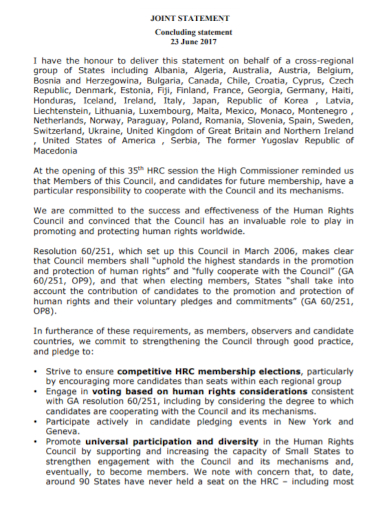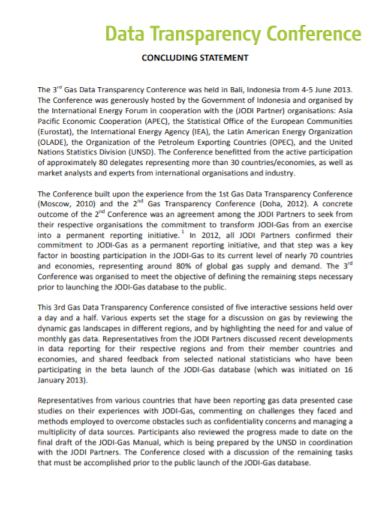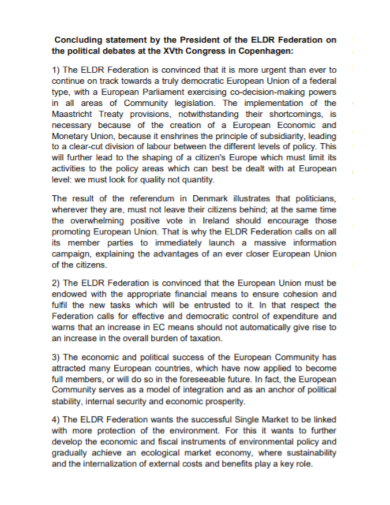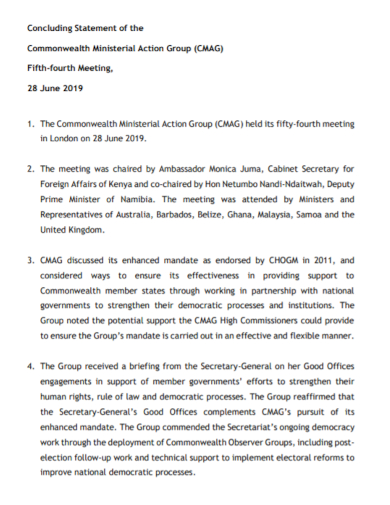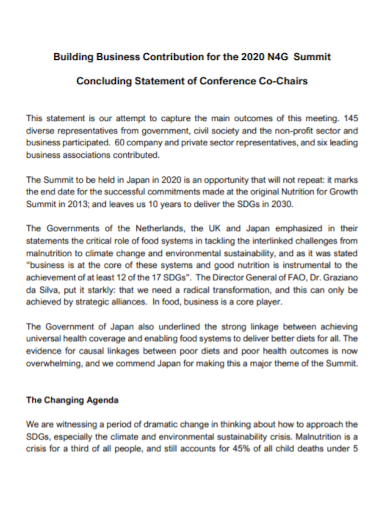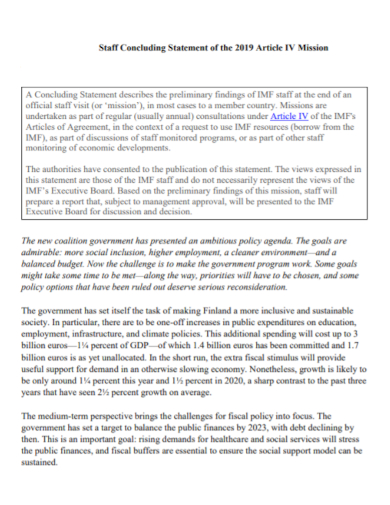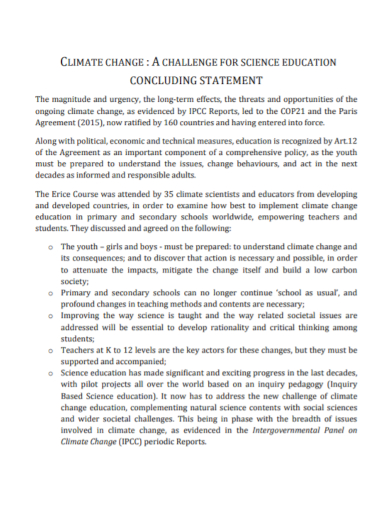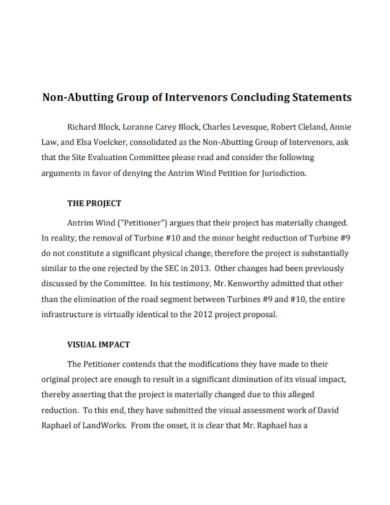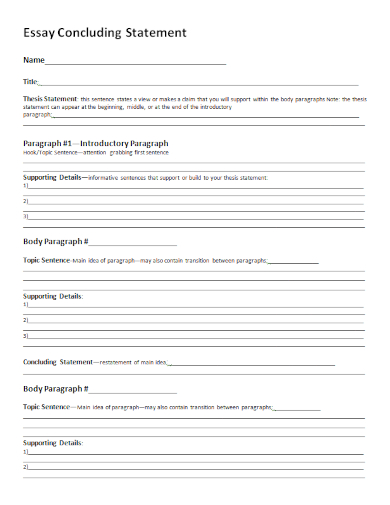Writing an essay is a very significant part of the learning process. Creating a clear and well-argued case in writing according to your proper research is one of the effective methods to demonstrate your personal insight and understanding about a specific topic or subject. Aside from writing a compelling introduction for your essay, you need to write an effective concluding statement as well. So, if you’re currently struggling on how you will end your write-up, we include an informative guide and printable concluding statement samples in this article that you can use. Please continue reading!
FREE 10+ Concluding Statement Samples
1. Joint Concluding Statement
2. Data Conference Concluding Statement
3. President Concluding Statement
4. Meeting Concluding Statement
5. Business Conference Concluding Statement
6. Staff Concluding Statement
7. Annual Meeting Concluding Statement
8. Climate Change Concluding Statement
9. Energy Poverty Concluding Statement
10. Project Concluding Statement
11. Essay Concluding Statement
What is a Concluding Statement?
A concluding statement is a simple and concise statement that contains a brief summary or overview of a certain literary piece or document. It is basically a short ending portion of a certain piece of writing.
How to Write a Concluding Statement
Remember that you need to get down to writing and consider it as a different form of thinking. As you jot down your own ideas, thoughts, and opinions on the paper, you’re just simply recording the words, phrases, and sentences coming from your mind. So, don’t be anxious if you’re having a hard time writing the conclusion of your article, essay, thesis paper, or any document that you need to work on. Below are important ways you can do to write a good concluding statement:
1. Use a rhetoric to convince your readers
When you write an effective concluding statement, you need to think carefully and set up a rhetoric like a sales pitch in order to convince or persuade your readers. This is essential for you to emotionally connect with the reader’s feelings and thoughts. Being one of the most significant disciplines throughout the Western society during the start of the 20th century, rhetorical abilities will help an individual to captivate and win over his or her readers in some ways.
2. Keep your paragraphs cohesive
After doing your best to convince your readers, you need to keep your paragraphs cohesive or make your work in harmonious order or unified as a whole. To accomplish cohesion on your writing, consider using word repetition, synonyms for key words and phrases, pronouns, and determiners while writing your personal journal, essay, or any write-up. Maintain connections between the ideas while avoiding too much repetition.
3. Include a motivating quote
We recommend that you include a motivating quote from your research while writing your document. When you include a quote that is related to your content, it frames your ideas and points from your piece of writing. Plus, it adds a different style to your work.
4. Let your readers feel a sense of closure
Lastly, write a short inspiring note to end your essay as you let your readers feel a sense of closure and satisfaction from your document. You can also encourage your readers to take a new perspective based on the main topic of your write-up. Your closing sentence or clincher should make your audience feel joy as they finish reading your paper and gain a new meaningful lesson that they can apply in their lives or share to others.
FAQ
Concluding statement wraps up the main points that a person demonstrated in his essay or any written document. It provides a clear summary of the highlighted ideas and emphasizes on the key words or phrases derived from the topic sentence of the write-up.What is the purpose of a concluding statement?
When you write a good concluding sentence for your report, you need to summarize the overall content of your write-up and highlight the key points.What makes a good concluding sentence?
The four types of concluding sentences for various types of academic papers are reflective, retrospective, projective, and embedded.What are the four types of concluding sentences?
If you are working on research papers for business, you can use different types of conclusions such as summarizing conclusion, editorial conclusion, externalizing conclusion and many more. What are different types of conclusions for research papers?
The most significant parts of a written document is the title, abstract, and conclusions. So, when you create an effective concluding statement, you need to place your primary findings, implications, and the significance of your work in the limelight. Try your best to think about the essence of your work and its lasting legacy. Your conclusion should be the answer to your research questions. To help you write a clear and compelling artist statement, you can click and download our short artist examples here!
Related Posts
FREE 17+ Sample Handover Reports
FREE 16+ Argumentative Writing Samples
How to End Thank-You Letters?
FREE 13+ Liquidity Management Samples
FREE 10+ Sample Business Partnership Contracts
FREE 10+ Bulk Sale Notice Samples
FREE 9+ Argumentative Essay Samples
FREE 8+ Counter Argument Samples
FREE 8+ Sample Resignation Letter
FREE 7+ Sample Financial Summary
FREE 29+ Termination Letter Templates
FREE 29+ Formal Request Letter Templates
FREE 25+ Sample Community Service Letter
FREE 12+ Essay Samples
FREE 11+ Court Character Reference Letter Samples

